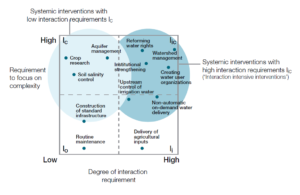Synthesis of strategic approaches: Enhancing pro-poor investments in water & rural livelihoods.
 The reduction of hunger and poverty depends on improved access to water for poor rural people. Progress in community water supplies and agricultural water management (AWM), particularly irrigation, is one of the success stories of the twentieth century. However, it is disappointing to learn that AWM, by far the largest consumer of water in developing countries, has had little impact on world hunger and poverty. The experience of agency- and government-led interventions has not been good. They often impose ‘blueprint’ methods that ignore important local issues. A critical gap exists between planning and successful implementation. Approaches focus on what needs to be done, rather than on how to do it, and they ignore the complex interactions among individuals, the state and service providers –as well as their limited capacity to translate plans into practice. If poor rural people are not to be the losers again in the struggle for declining water resources, a new, pro-poor water management strategy is needed. It must focus more on how to do it, while still addressing what to do, where and with whom.
The reduction of hunger and poverty depends on improved access to water for poor rural people. Progress in community water supplies and agricultural water management (AWM), particularly irrigation, is one of the success stories of the twentieth century. However, it is disappointing to learn that AWM, by far the largest consumer of water in developing countries, has had little impact on world hunger and poverty. The experience of agency- and government-led interventions has not been good. They often impose ‘blueprint’ methods that ignore important local issues. A critical gap exists between planning and successful implementation. Approaches focus on what needs to be done, rather than on how to do it, and they ignore the complex interactions among individuals, the state and service providers –as well as their limited capacity to translate plans into practice. If poor rural people are not to be the losers again in the struggle for declining water resources, a new, pro-poor water management strategy is needed. It must focus more on how to do it, while still addressing what to do, where and with whom.
Synthesis of strategic approaches: Enhancing pro-poor investments in water & rural livelihoods.
Authors: Cleveringa, R., Kay, M., & Cohen, A.
Publication Year: 2009 | Journal / Publisher: Rome: United Nations International Fund for Agricultural Development
 The reduction of hunger and poverty depends on improved access to water for poor rural people. Progress in community water supplies and agricultural water management (AWM), particularly irrigation, is one of the success stories of the twentieth century. However, it is disappointing to learn that AWM, by far the largest consumer of water in developing countries, has had little impact on world hunger and poverty. The experience of agency- and government-led interventions has not been good. They often impose ‘blueprint’ methods that ignore important local issues. A critical gap exists between planning and successful implementation. Approaches focus on what needs to be done, rather than on how to do it, and they ignore the complex interactions among individuals, the state and service providers –as well as their limited capacity to translate plans into practice. If poor rural people are not to be the losers again in the struggle for declining water resources, a new, pro-poor water management strategy is needed. It must focus more on how to do it, while still addressing what to do, where and with whom.
The reduction of hunger and poverty depends on improved access to water for poor rural people. Progress in community water supplies and agricultural water management (AWM), particularly irrigation, is one of the success stories of the twentieth century. However, it is disappointing to learn that AWM, by far the largest consumer of water in developing countries, has had little impact on world hunger and poverty. The experience of agency- and government-led interventions has not been good. They often impose ‘blueprint’ methods that ignore important local issues. A critical gap exists between planning and successful implementation. Approaches focus on what needs to be done, rather than on how to do it, and they ignore the complex interactions among individuals, the state and service providers –as well as their limited capacity to translate plans into practice. If poor rural people are not to be the losers again in the struggle for declining water resources, a new, pro-poor water management strategy is needed. It must focus more on how to do it, while still addressing what to do, where and with whom.
PDF on Publisher Website | PDF on OSF
